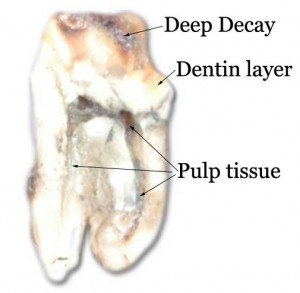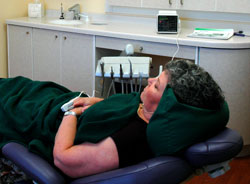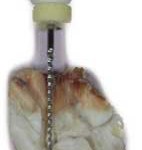Every tooth during its development contains a dental pulp in the center of the hard tooth. The hard tooth comprises a tooth structure called dentin and is covered with a thinner enamel veneer. The pulp at the center of the tooth comprises soft tissue that comprises the blood supply to the tooth and nerve tissue that conveys the sensitivity commonly felt in tooth-related discomfort.
When the dental pulp is irritated or injured by trauma, the pulp becomes inflamed, and the tooth becomes very sensitive. The most common irritation is tooth decay, but biting trauma or trauma from an injury such as a fall or heavy blow to the mouth can also cause varying degrees of tooth sensitivity and other problems. Sensitivity to cold and sweet that last only for a few seconds is often a sign of a reversible condition. The symptoms resolve if the source is tooth decay and the decay is removed from the tooth. Tooth decay is the most common bacterial disease in the world today. (see What is Tooth Decay) If the source of sensitivity is trauma and the tooth is given a rest from pressure through several means, then there is a good chance that the sensitivity will resolve. Sensitivity to cold, hot, and sweets that linger for minutes or come on without provocation is generally a sign of greater damage to the pulp. This is typical of a decayed tooth where the cavity (decay) has reached the dental pulp.
Tooth decay is caused by germs (bacteria) normally present in the mouth. In a healthy tooth, the pulp tissue is sterile because the hard surface of the dentin and enamel surrounds it. When germs invade through the enamel and into the dentin, nerve endings in the dentin that travel to the nerve in the pulp are sensitized. If the decay travels directly into the pulp, the pulp is no longer sterile, and the germs can grow using the pulp tissue as a medium. When the pulp is irreversibly damaged, as described here, a person may still be able to save their tooth through endodontics or what is commonly called root canal therapy. The decay process or traumatic damage to the tooth must be such that the tooth can still be adequately fixed with some form of dental restoration. This dental restoration must prevent or minimize the chance of future fractures of the remaining tooth. The American Association of Endodontics (AAE) recommends that any back tooth that had root canal treatment receive a restoration that covers or in some way protects the remaining tooth from forces strong enough to break or crack the tooth. Restoring the tooth with a permanent restoration is also important to prevent germs in the mouth from re-entering the tooth, causing a re-infection of the tooth. Even if it is possible to perform root canal treatment if it appears that the tooth is so badly damaged, it is best to remove the tooth and discuss alternatives, such as replacing the tooth with an implant or bridge. Once elected, endodontic or root canal treatment goals are to remove all the dental pulp tissue in the tooth and to seal the space in the center of the tooth occupied by the dental pulp. This must be performed comfortably for the patient; therefore, a local anesthetic (Novocain) is used. In some cases, nitrous oxide analgesia (laughing gas).
The picture shows a relaxed patient under sedation, or in some instances, oral-conscious sedation medication may also be used to keep the patient comfortable during the root canal procedure. The tooth is isolated from the rest of the mouth, typically with a rubber membrane called a dental dam. It is important that in cleaning the infected pulp tissue from the tooth, germs from the mouth do not have access to the tooth being treated. The dental dam is the best way to accomplish this. The dentist will typically use a drill to locate the pulp and remove any overlying tooth structure to allow complete visualization of the pulp and its’ entrance into the tooth’s roots. There can be one or several roots in a tooth, depending on whether it is a front or back tooth. The pulp entrance to each root needs to be located as the goal is the total removal of all pulp tissue.
Root Canal File cleaning pulp from the root of the tooth. The dentist uses small delicate instruments called root canal files to access and remove the pulp tissue. These files may be finger-held instruments or on a specially designed drill to remove the pulp in a minimal amount of time efficiently. At we use the Endo Sequence Rotary Files by Brasseler for their predictable results with maximum ease in handling. During the procedure, the pulp tissue is irrigated out of the tooth with a solution of Sodium Hypochlorite. Irrigation both dissolves dental pulp and disinfects the inner part of the tooth and roots that contain the pulp. At we use a special unique irrigating system called Endo-Vac by Discuss Dental, which is superior to other irrigation methods in effectively dissolving and flushing pulp and canal debris from the inside of the tooth. Root canals can be windy; the files straighten the canals inside the tooth with a precise cone shape, with the canal always slightly wider from the tip of the root to the top of the canal. Sealer material called “gutta-percha,” precisely sized to the last width file used, is cemented in place with a small amount of cement sealer. With modern techniques, most root canals can be completed in just one visit with little or no discomfort.
 Ocotillo Dental Care, Jeffrey S. Garelick, DDS
Ocotillo Dental Care, Jeffrey S. Garelick, DDS
Chandler, AZ 85248
Office: (480) 855-1994




